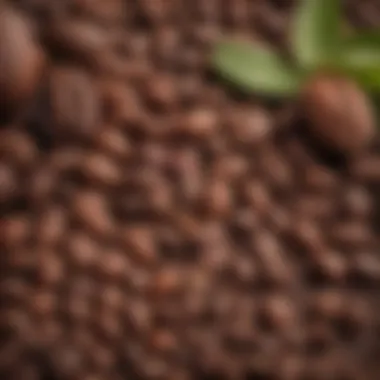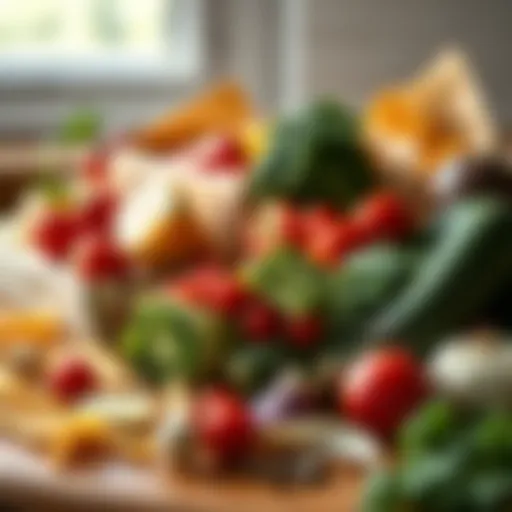Danish Chocolate: Tradition and Craftsmanship Uncovered


Intro
Danish chocolate embodies a tradition steeped in both history and artistry. The journey of chocolate in Denmark is not just about indulgent treats but a narrative woven with the threads of local culture, innovative techniques, and premium ingredients. This exploration is not just a mere glance at chocolate but a profound dive into its depths. Each bite reveals a story, echoing centuries of craftsmanship and love for perfection. Let’s embark on this journey to discover the secrets behind Danish chocolate, pinpointing what makes it a treasured delight on the global stage.
Ingredients Breakdown
Primary Ingredients
The crafting of exquisite Danish chocolate starts with a handful of essential ingredients that form the backbone of its rich flavors and textures. At the forefront, we have:
- Cocoa Beans: The soul of chocolate, these beans are sourced from various regions, each offering distinct taste profiles. In Denmark, the focus is often on high-quality, ethically sourced beans.
- Cocoa Butter: This natural fat extracted from cocoa beans adds a creamy mouthfeel and helps in tempering the chocolate to achieve that perfect shine and snap.
- Sugar: Danish chocolate tends to balance the natural bitterness of cocoa with just the right amount of sweetness, often using cane sugar for its clean flavor.
- Milk Powder: For milk chocolates, finely processed milk powder is crucial. Denmark showcases its dairy heritage by utilizing top-notch milk products.
Optional Ingredients
Additional ingredients elevate the craft of Danish chocolate, allowing artisans to experiment with flavors and textures:
- Vanilla: Often included to enhance the chocolate’s flavor, it adds depth and aromatic notes.
- Salt: A touch of sea salt can amplify the chocolate's rich flavors, providing a contrasting bite that brings out the sweetness.
- Nuts and Fruits: Almonds, hazelnuts, or dried fruits can be incorporated, adding crunchiness and layers of flavor.
Essential Kitchen Tools
To create delightful Danish chocolate experiences at home, having the right tools is paramount:
- Double Boiler: For gentle melting of chocolate without scorching.
- Thermometer: Crucial for tempering chocolate to achieve the right consistency and shine.
- Silicone Molds: Perfect for shaping your creations into various forms.
- Spatula: A must for stirring and ensuring all ingredients combine seamlessly.
Step-by-Step Preparation
Prepping the Ingredients
Before one dives into the melting and mixing process, it’s essential to prep your ingredients carefully. Grate or chop any chocolate, measure out sugar, and have your molds ready to go. This ensures a smooth workflow, akin to having all your ducks in a row.
Cooking Techniques and Methods
One of the most rewarding aspects of Danish chocolate making is the fusion of traditional techniques with modern practices. The process typically includes:
- Melting: Begin by melting your chocolate using a double boiler. This allows for an even melt, avoiding any of the dreaded burning.
- Tempering: This step is crucial for achieving that characteristic snap. Bringing the chocolate to specific temperatures enhances its stability.
- Mixing: Once tempered, incorporate any optional ingredients like vanilla or sea salt, ensuring an even distribution.
Assembly and Presentation Tips
The allure of chocolate also lies in its presentation. Here are some thoughts on creating visual appeal:
- Use vibrant molds to give unique shapes and designs.
- Decorate with sea salt or chocolate shavings for added texture.
- Serve on wooden boards or elegant platters to elevate the experience.
Dietary Considerations
Gluten-Free Options
Interestingly, traditional Danish chocolate inherently aligns with gluten-free diets, given its primary ingredients. Always check labels, however, especially with added flavors.
Vegetarian and Vegan Substitutes
Danish chocolate can be made vegan by substituting milk powder with plant-based alternatives like almond or soy milk powder.
Nutrition Facts & Nutritional Considerations
Moderation is key. Rich in antioxidants, chocolate can offer health benefits, but it’s still a treat. Check the nutritional labels for sugar content and portion sizes.
Variations and Customizations
Flavor Enhancements
To make your Danish chocolate stand out, consider:
- Adding spices like cinnamon or chili for a kick.
- Infusing with citrus zest for a refreshing twist.
Alternative Cooking Methods
Experiment with methods such as:
- Molecular gastronomy, where chocolate can be transformed into foams or spheres.
- Chocolate truffles, where you roll ganache into delightful bite-sized treats.
Pairing Suggestions (Sides, Drinks, etc.)
Here the sky is the limit:
- Pair with a rich red wine or a robust espresso to enhance flavors.
- Serve alongside fruits like strawberries or orange slices to add a refreshing contrast.
Common Help Sections and Troubleshooting
Frequently Asked Questions
- Can I store chocolate? Yes, keep it in a cool, dry place away from strong odors.
- Why is my chocolate dull? Dulling may happen if it wasn’t tempered correctly.
Common Mistakes to Avoid
Avoid overcooking the chocolate, as heat can dull its quality. Also, be careful with moisture—water and chocolate don’t mix!


Solutions to Potential Problems
If your chocolate seizes, add a small amount of coconut oil and gently heat it until it merges again.
Danish chocolate represents not just quality but a heritage of craftsmanship that keeps evolving, rooted deeply in tradition yet open to innovation.
Historical Context of Danish Chocolate
Understanding the historical context of Danish chocolate is paramount to appreciating its current standing in the global chocolate market. The rich tapestry of Denmark’s chocolate history has been woven through centuries of change, cultural exchange, and innovation. By examining the origins and growth of chocolate in Denmark, readers can glean insights into how this beloved delicacy came to be a staple in Danish cuisine and culture.
Early Forewords to Chocolate
Danish chocolate didn’t just pop up overnight; it was introduced to Denmark in the early 17th century, likely through trade routes that connected Europe with the Americas. Spain, being the first European nation to savor chocolate, played a key role in this introduction. The drink quickly gathered steam, with the elite class initially embracing chocolate as a luxurious beverage. Rich, spiced concoctions often made from cacao, sugar, and vanilla began making their way into the royal courts.
An interesting story revolves around King Frederick IV, who visited the Netherlands in 1700, where he encountered chocolate. He was so taken by it that upon returning to Denmark, he brought along recipes and knowledge of chocolate-making. This sparked an interest in the Danish elite, who began indulging in what they considered a rare treat.
As time went on, the practice of making chocolate beverages spread beyond the nobility. It transitioned from opulent dining rooms to wider society, setting the stage for what would become a national passion. By the 19th century, chocolate houses began opening in Copenhagen, mirroring the trend seen in other European metropolises.
Growth of Chocolate Culture in Denmark
Fast forward to the mid-19th century, and Denmark's chocolate culture took a turn for the better when chocolate manufacturing began to industrialize. Companies like Anthon Berg and La Glace Café emerged, contributing to a burgeoning chocolate industry. During this time, the Danish people’s love for chocolate not only grew; it became a part of everyday life.
The establishment of local chocolatiers ramped up the competition, yet it also drove quality improvements. Chocolatiers like Kraft Karameller and Summerbird used fine, local ingredients, elevating Danish chocolate to new heights with innovative flavors and textures. Danish chocolate started to be associated with craftsmanship and artisanal methods, moving beyond just being a sweet treat.
Several factors contributed to this growth:
- Accessibility of Ingredients: With the advent of improved trade routes, cacao became more readily available, leading to lower costs.
- Industrial Advancements: Innovations in machinery allowed for better processing of chocolate, creating smoother textures and more consistent flavors.
- Changing Consumer Tastes: Denmark's evolving society started to embrace chocolate not just during special occasions but also as a regular indulgence.
"Chocolate is not just a treat; it reflects Denmark's transition from elite luxury to a democratic indulgence."
In summary, the historical context of Danish chocolate illustrates an intriguing blend of cultural influences and innovations over time. From its introduction as an exotic drink to a cherished part of everyday life, Danish chocolate has evolved and established a strong identity on the world stage.
Key Characteristics of Danish Chocolate
Understanding the key characteristics of Danish chocolate is essential to fully appreciate its rich heritage and unique qualities. Danish chocolate stands apart not only for its flavor but also for the experience it offers to those who indulge in it. The balance of texture and the usage of local ingredients contribute to a chocolate that resonates deeply with both gourmands and casual eaters alike. This section aims to shed light on these critical aspects, weaving together how they create a tapestry of taste that is distinctly Danish.
Texture and Flavor Profiles
The texture and flavor of Danish chocolate can be likened to a carefully brewed cup of coffee—each sip revealing layers that contribute to a complex yet harmonious experience. This chocolate often boasts a silky mouthfeel, which is a result of the meticulously crafted tempering process that artisans employ. The cocoa butter’s consistency can make a world of difference, resulting in chocolates that either melt effortlessly on the tongue or provide a satisfying snap when broken.
Flavor profiles in Danish chocolate are as varied as the Danish landscape itself. Traditional dark varieties pack a punch of intense cocoa notes that can be both earthy and fruity, capturing the essence of high-quality cacao sourced from reputable regions. On the other hand, the milk chocolates often exhibit a creamy sweetness with hints of caramel, making them approachable for nearly any palate. For those feeling adventurous, some artisanal varieties incorporate unique flavorings, like sea salt or lavender, which bring a fresh twist to classic flavors.
"Danish chocolate is not merely a treat; it’s a celebration of craftsmanship and innovation."
Key flavors to explore include:
- Bittersweet notes: Ranging from fruity to nutty, often found in dark varieties.
- Caramel undertones: Common in milk chocolates, enhancing their richness.
- Innovative flavors: Explore unexpected pairings like chili or herbs that redefine taste boundaries.
Use of Local Ingredients
One of the most compelling aspects of Danish chocolate is its adherence to local sourcing, which brings an authentic taste to its production. With a strong emphasis on sustainability and quality, many chocolatiers in Denmark have developed relationships with local farmers and suppliers to ensure that their ingredients are not only fresh but also grown with care.
Example of local ingredients include:
- Danish Butter: Used in creating fillings, it lends a rich creaminess that defines many classic Danish chocolates.
- Nuts: Many chocolatiers proudly use nuts sourced from local farms, which add texture and richness.
- Herbs and Spices: Unique regional flavors, such as wildflower honey or locally grown herbs, are often infused to create signature bars that cannot be found anywhere else.
The practice of utilizing local ingredients not only ensures quality but also promotes sustainability within the community. By supporting local agriculture, chocolatiers are not just creating chocolates; they are fostering a culture of collaboration that resonates throughout the Danish culinary landscape.
Artisanal Chocolate Production
In the world of food that tantalizes the taste buds, artisanal chocolate stands as a testament to craftsmanship and culinary artistry. This section aims to shed light on the nuances of artisanal chocolate production in Denmark, a country known for its high-quality confections. The focus is on manual processes that pay homage to traditional techniques, blended with a pinch of modern innovation, resulting in products that are not just snacks, but a luscious experience bursting with flavor.
Traditional Methods
Let's begin by diving into traditional methods of chocolate making. Danish chocolatiers often stick close to classic techniques that have actually stood the test of time. They favor small-batch production, which allows for greater control over the quality of every chocolate bar or truffle crafted.
One might find methods such as bean-to-bar practices prevalent among many artisans. In these scenarios, chocolate makers meticulously select the cacao beans, ensuring only the finest seeds make the cut, followed by slow roasting to develop rich flavor profiles. No rushing here—patience is the name of the game. Danes, known for their hygge lifestyle, bring a sense of warmth and comfort into their chocolate crafting, making sure each stage is executed with care.
"Crafting chocolate is not merely a trade; it's an old-world art that demands both passion and precision."
They often utilize techniques like conching and tempering, where they refine the chocolate’s texture and enhance its mouthfeel. These processes can take hours and often involve hand-operated machines, allowing for a personal touch that large-scale producers tend to overlook. This bit of old-style craftsmanship shines through in each bite, resulting in chocolates that melt in your mouth yet show a resilience in structure.
Innovations in Chocolate Making
Now, innovations might sound a bit removed from tradition, but in the Danish context, they are rather complementary. The approach towards chocolate production has seen shifts, most notably through the incorporation of local ingredients like spices and herbs unique to Nordic cuisine. For instance, pairing chocolate with sea buckthorn or caramelized linseed speaks to a keen relationship between the regional palette and chocolate-making.
Moreover, many artisanal chocolatiers are embracing eco-friendliness into the process. With growing awareness regarding sustainability, some Danish brands are exploring innovations that not only taste good but also do good, such as biodegradable packaging and sourcing cacao directly from farmers involved in fair trade practices. It’s a melding of community-supportive initiatives and taste that resonates with a growing demographic caring for the planet.
The use of technology is also not an alien concept. Data-driven techniques such as temperature-controlled environments during chocolate setting are becoming common practice, ensuring consistency and quality oversee the entire production chain. These advancements help maintain the delicate balance of flavor and texture that Danes have come to expect, while also opening doors to discussions about flavor fusion and experimental pairings that might have once been thought impossible.
In summary, when it comes to artisanal chocolate production in Denmark, the combination of robust traditional methods with modern innovations offers a thrilling tasting journey. Entering into this world is akin to walking through a chapter of culinary history, where every bite tells a story, rooted deeply in both heritage and creativity, for both chocoholics and novices alike.
Popular Varieties of Danish Chocolate
Danish chocolate is not just a confectionery delight; it's a celebration of craftsmanship and flavor. Understanding the various forms Danish chocolate takes opens up a world of taste experiences both traditional and innovative. Each variety holds its own story and significance, blending local traditions with modern preferences. Exploring these options gives chocolate lovers a chance to appreciate the art behind every bite.


Dark Chocolate Delights
Danish dark chocolate has carved out a niche for itself, often celebrated for its rich, intense flavors that transport consuers straight to a world of pure cocoa essence. Unlike many mass-produced alternatives found globally, here in Denmark, the dark chocolate is often crafted with a meticulous eye for quality.
One noteworthy aspect is the percentage of cocoa. Many artisans proudly create chocolates with a high cocoa content, resulting in a deep, slightly bitter flavor profile enhanced by natural notes of fruit or spice. The use of organic cocoa beans from Fair Trade certified farms is not uncommon in this sector, ensuring both ethical practices and remarkable taste.
"Danish dark chocolate, with its complex flavors, tells a story that transcends borders."
When it comes to tasting, significant attention should be paid to the pairing of dark chocolate delights with various foods. Here are a few examples:
- Fresh berries: The sweetness contrasts the bitterness beautifully.
- Strong cheeses: Cheddar or blue cheese work wonders together.
- Spicy foods: Think chipotle or curry for an exciting flavor dance.
Milk Chocolate Offerings
Milk chocolate in Denmark has taken on its own charming persona, known for its creamy texture and balanced sweetness. Unlike typical mass-market milk chocolates that may overwhelm with sugar, the Danish offerings often emphasize a more natural sweetness blended with quality cocoa, resulting in a delightful interplay of taste.
Besides the general appeal of smooth and creamy textures, what makes Danish milk chocolate stand out is its use of local dairy ingredients. Many brands incorporate milk from cows grazed on the lush, green pastures of Denmark, creating a product that reverberates with authenticity and depth of flavor. This milk contributes to a silky consistency that envelops the palate, making every bite an indulgent experience.
Some of the interesting pairings for milk chocolate include:
- Cinnamon rolls: A match made in pastry heaven.
- Nuts: Almonds or hazelnuts provide a pleasant crunch.
- Lightly roasted coffee: The bitterness balances the sweetness.
Specialty Flavors and Combinations
The creativity of Danish chocolatiers shines brightest within the specialty flavors and combinations. Here, innovation meets tradition as artisans experiment with local ingredients and daring flavors. From sea salt caramel to exotic spice-infused blends, these chocolates not only taste divine but also evoke a sense of adventurous spirit.
Local ingredients like sea buckthorn or elderflower are often incorporated, influenced by traditional Danish culinary practices. The result is a chocolate bar that transports the taster to the Scandinavian countryside in one bite, full of surprising yet harmonious flavors.
Chocolatiers are not afraid to push the envelope by experimenting with:
- Herbal notes: Rosemary or thyme can introduce a fragrant twist.
- Citrus infusions: Lemon zest or orange essence awakens the flavor.
- Boozy blends: Infusing chocolate with local spirits like aquavit adds sophistication.
Overall, the world of Danish chocolate varieties is as diverse as it is delightful. Each type brings something unique to the table, making the experience of enjoying Danish chocolate a multifaceted adventure.
Cultural Significance of Chocolate in Denmark
Chocolate in Denmark holds a unique place, far beyond mere confectionery. It intertwines with the country’s history, local culture, and societal gatherings, making it a significant element in everyday life as well as special occasions. This section seeks to illuminate the ways in which chocolate is celebrated in Danish culture, emphasizing its role in festivities and social traditions.
Chocolate in Danish Festivities
In Denmark, certain occasions are simply not the same without chocolate. Birthdays, anniversaries, and seasonal celebrations often see chocolate take center stage. For instance, during Fastelavn, a festivity marking the start of Lent, families embrace the tradition of eating sweet buns filled with chocolate. This time-honored treat, called "Fastelavnsbolle", consists of a soft, sweet bun often decorated with cream and chocolate; it symbolizes the joyous farewell to indulgence before the somber days of Lent.
Similarly, Christmas in Denmark is a time for chocolate, too. The practice of exchanging chocolate treats, especially pralines or chocolate-covered marzipan, strengthens bonds among family and friends. Kids look forward to the julekalender, an advent calendar filled with chocolate, offering a daily sweet reminder of impending festivities. This act of gifting and sharing chocolate fosters warmth and togetherness, cementing its stature as a beloved festive element.
"Chocolate brings a sweet cheer to times of joy and festivity, helping to create shared experiences and cherished memories."
Role of Chocolate in Social Traditions
Beyond festivities, chocolate has woven itself into the fabric of daily social life in Denmark. It serves as more than just a treat; it's a medium for connection. Evening gatherings often feature chocolate desserts or drinks, encouraging camaraderie among friends and family. Here, the rich, velvety texture of chocolate complements conversations, making even simple gatherings feel like significant events.
Moreover, coffee shops, known as caféer, incorporate chocolate into their offerings, providing a cozy atmosphere for socializing. Couples, friends, and colleagues often linger over cups of hot chocolate or cakes laden with chocolate, embracing meaningful conversations over shared experiences.
On a deeper level, chocolate reflects Danish values of sustainability and craftsmanship. Many communities celebrate local chocolatiers who focus on ethical sourcing, ensuring that chocolate consumption aligns with cultural consciousness. Initiatives to promote locally made chocolate not only bolster community pride but also cultivate an appreciation for quality and sustainability.
Pairing Danish Chocolate with Food and Beverages
Pairing Danish chocolate with various food and beverages is an art form. It involves an understanding of flavors, textures, and aromas that complement each other, enhancing the overall tasting experience. This is particularly important in the context of Danish chocolate, where the rich tradition and artisanal craftsmanship come into play. The goal here is not just to enjoy the chocolate itself, but to engage in an exploration of how it harmonizes with other culinary delights.
Finding the right pairings can elevate a simple chocolate experience into something truly memorable. Each bite of Danish chocolate brings forth unique flavors, which can be accentuated or mellowed by the right companions. This section will dive into complementary flavors and beverage pairings that create a symphony on the palate.
Complementary Flavors
When it comes to pairing Danish chocolate with food, it's essential to consider complementary flavors. The richness of dark chocolate can be balanced by the acidity of certain fruits, while milk chocolate might blend beautifully with creamy or nutty elements. Here are some popular combinations:
- Fruits:
- Nuts:
- Cheese:
- Spices:
- Berries like raspberries or strawberries can provide a tart balance to the sweetness of chocolate.
- Citrus such as orange or lemon zest can brighten the chocolate's flavor.
- Almonds or hazelnuts pair well with both dark and milk chocolates, adding a crunchy texture.
- Pecan nuts can also enhance the chocolate's buttery notes.
- Certain cheeses, particularly aged cheddar or goat cheese, create a rich contrast with dark chocolate.
- A drizzle of honey can round out the flavors beautifully.
- Spices like cinnamon or cayenne can add warmth and a kick to the chocolate experience.
- cardamom can also introduce a unique aromatic note.
All these combinations serve to augment the chocolate's inherent flavors, creating a layered tasting experience.
Beverage Pairings
No chocolate experience is complete without the right beverage to wash it down. Here, the focus shifts to how different drinks can enhance the flavors of Danish chocolate. A few noteworthy suggestions include:
- Wine:
- Coffee:
- Tea:
- Craft Beers:
- Red wine, especially fruity varieties like Merlot or Malbec, can pair wonderfully with dark chocolate.
- Port is also a classic choice, its sweetness contrasting beautifully with the rich, bitter notes of chocolate.
- A bold espresso can complement the complex flavors of high-quality chocolate, enriching the experience.
- Cappuccino can also offer a creamy counterpart, especially with milk chocolates.


- Black tea, with its robust flavor, can stand up to more intense chocolate.
- Green tea, with its herbal notes, creates a refreshing contrast, especially with milder varieties.
- Dark ales or stouts add a hoppy bitterness that can play off the chocolate’s sweetness.
- A light lager can cleanse the palate between bites of rich chocolate.
As you explore these pairings, remember that the key is balance. Each pairing should enhance the experience without overwhelming the palate.
"The perfect pairing isn't just about the flavors coming together; it's about creating a whole narrative of taste that transports you to another realm."
Sustainability in Chocolate Production
As the global market for chocolate continues to evolve, the focus on sustainability in chocolate production has grown more significant. This aspect is not merely a trend; it is a clarion call for chocolate makers in Denmark to reconsider how they source ingredients and manage their production processes. Sustainability encompasses various elements, from ethical sourcing of ingredients to minimizing environmental impact. By diving into these details, we can uncover how Danish chocolatiers are paving the way for responsible and conscious chocolate consumption.
Ethical Sourcing of Ingredients
In the realm of chocolate, ethical sourcing is about more than just fair trade practices—it's a commitment to sustaining communities that produce cocoa. Danish chocolate makers often prioritize sourcing their cocoa from farms that adhere to strict ethical standards, ensuring farmers are paid fairly and work under safe conditions. This holistic approach not only supports the livelihoods of farmers but also promotes biodiversity and environmental preservation.
A noteworthy aspect is the increasing cooperation between chocolate companies and local growers. One example would be partnerships with organizations dedicated to improving agricultural practices in cocoa-growing regions. This collaborative effort helps to ensure that high-quality cocoa beans are harvested while empowering farmers through training in sustainable practices. As a result, consumers can enjoy their indulgence knowing that they are supporting fair employment opportunities and ecological balance.
Environmental Considerations
Sustainability does not stop with ethical sourcing; it extends deeply into environmental considerations. The chocolate industry is facing significant challenges due to climate change, which affects cocoa production. As temperatures rise and weather patterns fluctuate, cocoa-growing regions are vulnerable, making environmental responsibility a critical concern.
Danish chocolate producers are increasingly implementing eco-friendly practices to mitigate these effects. For instance, the use of organic farming methods is on the rise. These practices avoid synthetic fertilizers and pesticides, thus preserving soil health and reducing pollution. Additionally, some producers are exploring agroforestry—growing cocoa trees alongside other crops, which can enhance biodiversity and create more resilient ecosystems.
The focus on minimizing carbon footprints is also noteworthy. Many Danish chocolate brands are shifting towards more sustainable packaging materials, aiming to reduce plastic use and transition to biodegradable options. By making these changes, they are not just improving their own practices, but also inspiring consumers to think more carefully about packaging waste and how it affects the planet.
"The future of chocolate lies not just in its taste, but in the legacy we leave Behind for the next generation. Ethical sourcing and environmental stewardship are the keys to this future."
Overall, sustainability in chocolate production signifies a movement towards a future where chocolate lovers can indulge guilt-free. As consumers, appreciating the impact of our choices leads to a more profound connection with the food we enjoy. Danish chocolate brands exemplify how the combined efforts of ethical sourcing and environmental considerations can create a sumptuous treat that also nurtures the earth and its people.
Health Aspects of Danish Chocolate
Danish chocolate holds not only a place of delight for the taste buds but also brings along various health facets that merit attention. While indulging in rich, creamy bits of chocolate, one can often overlook the nutritional benefits interlaced within its sweet embrace. This section aims to shed light on the importance of understanding the health aspects associated with Danish chocolate, providing a layout of its nutritional values, benefits, and some key considerations to keep in mind.
Nutritional Benefits
Danish chocolate, particularly dark chocolate, is lauded for its health benefits, attributed to its high cacao content. Whether you savor a piece of Mørk Chokolade or a smooth praline, you're not just enjoying a treat; you also receive a noteworthy dose of nutrients. Here are some highlights:
- Antioxidants: Dark chocolate is packed with flavonoids, plant compounds that act as antioxidants. They help combat free radicals in the body and may aid in reducing oxidative stress.
- Heart Health: Studies suggest that moderate consumption of dark chocolate may lower the risk of heart disease. The flavonoids can promote better blood flow, reduce blood pressure, and improve overall heart health.
- Mood Enhancer: Consuming chocolate can boost serotonin levels thanks to the compounds found in cacao, potentially making you feel happier. This is often referred to as a natural mood lifter.
- Mineral Rich: Danish chocolate contains essential minerals, including calcium, iron, magnesium, and copper. Each of these contributes to overall well-being, supporting bodily functions ranging from bone health to better immune response.
"A little piece of chocolate a day keeps the blues away!"
The health benefits come forth not only from the delightful taste but also from the mindful selection of high-quality ingredients often used by Danish chocolatiers. It's essential to choose chocolate with at least 70% cacao to reap the most health benefits.
Moderation in Consumption
While the benefits of Danish chocolate are appealing, moderation is the name of the game. It’s easy to become enchanted by the sweet allure of chocolate and indulge beyond reasonable limits. Here’s where the practical aspect of moderation becomes important:
- Caloric Intake: Chocolate, no matter how rich in nutrients, maintains a caloric density that can contribute to weight gain if consumed in excess. Watch out for large portions, particularly with high-calorie milk chocolates or creamy fillings.
- Sugar Content: Many varieties of Danish chocolate may have high sugar levels that can lead to spikes in blood sugar. Keeping an eye on sugar intake is crucial for maintaining overall health.
- Personal Health Considerations: Individuals with certain health conditions, like diabetes or heart issues, should consult dietary recommendations with healthcare providers before indulging in chocolate.
Exploring Danish Chocolate Beyond Borders
Danish chocolate has a story to tell, and it doesn't just stop at the borders of Denmark. The exploration of this sweet delicacy beyond its native land shines a light on the interconnectedness of global culinary practices. By understanding how Danish chocolate makers contribute to the international market, you reveal not only the unique qualities of their craft but also how these chocolatiers are adapting and fusing with other cultures to expand their influence.
The importance of exploring Danish chocolate beyond borders lies in its impact on the broader chocolate landscape. As Danish products thread through various markets, they raise questions about quality, sustainability, and innovation. There’s a palpable curiosity among consumers about where their chocolate hails from and how these producers are influenced by global trends. Furthermore, this exploration enhances appreciation for the art of chocolate making, allowing enthusiasts to see its evolution in the context of world cuisine.
Global Impact of Danish Chocolate Makers
When Danish chocolate makers set foot in the global arena, they carry more than just cocoa. They impart a commitment to craftsmanship and quality that resonates across continents. For instance, brands like Daldorf Naturals and Summerbird showcase how Danish techniques emphasize flavor and texture while utilizing organic, locally sourced ingredients. The reputation of Danish chocolate extends beyond palates; it stands as a testament to meticulous craftsmanship and sustainability.
"The beauty of Danish chocolate is not merely in its taste but in its journey from bean to bar, reflecting values that many global consumers now cherish."
Danish chocolatiers actively participate in international fairs and chocolate competitions, winning awards that spotlight their unique flavors. These accolades facilitate a dialogue between concoctions rooted in Danish tradition and innovative practices brought in by their international peers. As they work alongside other chocolatiers, you'll find exciting collaborations sprouting, blending methods and flavors from diverse culinary worlds.
Cross-Cultural Chocolate Fusions
One of the most intriguing aspects of Danish chocolate's journey beyond its borders is the cross-cultural chocolate fusions that emerge. The ability to adapt and integrate local influences speaks volumes about the versatility of Danish chocolatiers. For example, it's not uncommon to find dark chcolate bars laced with exotic spices like cardamom or chili, reflecting both Nordic heritage and inspiration from other global cuisines.
Danish chocolate has been melded with flavors from Asia, Africa, and the Americas, creating hybrid tastes that delight adventurous palates. Here are some notable fusions:
- Chocolate and Matcha: This unique pairing blends the traditional Danish chocolate flavors with Japanese matcha, offering a visual and taste experience that is both refreshing and rich.
- Cocoa and Sea Salt: A nod to Danish coastlines, this combination incorporates maritime flavors, showing a commitment to regional identity while embracing a universal culinary trend.
- Chili-infused Chocolate: The fiery kick from chilies mirrors trends seen in Latin American chocolate-making, symbolizing a bold step forward in flavor exploration.
Future Directions for Danish Chocolate
As we look ahead, the future of Danish chocolate appears both promising and dynamic. It's crucial to understand how this segment will evolve within the broader context of culinary trends, environmental considerations, and consumer preferences. Several specific elements define this direction and illustrate how innovations and sustainability can lead to a richer chocolate experience.
Trends in Chocolate Consumption
In recent years, a noticeable shift has occurred in how people approach chocolate. The modern consumer increasingly places importance not just on flavor but also on the origin and integrity of the product. Some significant trends shaping this landscape include:
- Health-Conscious Choices: With a growing awareness of health and wellness, many individuals are opting for dark chocolate varieties that offer lower sugar content and higher antioxidant properties.
- Artisanal Appeal: The boutique chocolate market has gained traction. Many chocolate enthusiasts are drawn to artisanal brands that emphasize handcrafted techniques and premium ingredients. This trend reflects a desire for authenticity and a connection to the maker.
- Sustainability Standards: Consumers now prioritize brands that adopt ethical sourcing practices. Chocolate made from beans harvested through fair-trade mechanisms resonates well among socially conscious buyers.
Overall, the future will likely see a continuation of these consumer preferences, which will further shape the Danish chocolate market.
Emerging Chocolatiers
As Denmark's chocolate scene continues to grow, exciting new chocolatiers are making their mark. These innovators blend traditional practices with modern philosophies, creating unique offerings that attract both locals and international customers. A few notable points include:
- Creative Flavors: Emerging chocolatiers often experiment with unconventional flavors, such as incorporating local herbs or spices to create distinct taste experiences.
- Collaborative Endeavors: Many new brands are collaborating with local artisans, be it cheesemakers, distillers, or bakers, to produce chocolate that's infused with regional flavors. The goal is not just to provide a sweet treat but a delicacy that tells a story.
- Tech-Driven Production: With advancements in technology, some chocolatiers are using innovative methods to enhance the production process while maintaining quality. Techniques such as precision tempering or bean-to-bar chocolate making are becoming more accessible to small producers.
In this ever-evolving landscape, both seasoned brands and new players have the chance to redefine what Danish chocolate can be. The melding of tradition and modernity ensures that Denmark will continue to be a key player on the global chocolate stage, appealing to both discerning enthusiasts and casual consumers alike.







